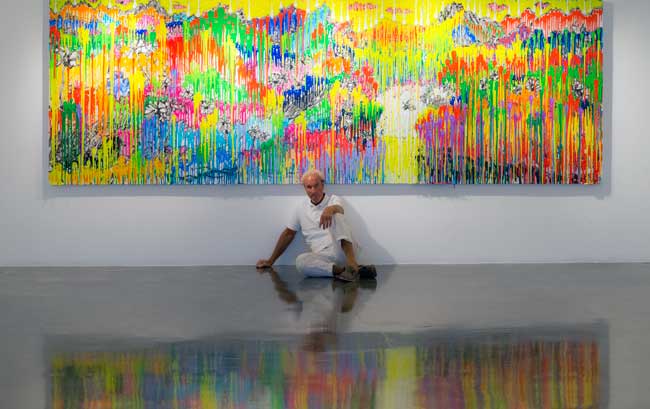 Working for 'Peanuts' Working for 'Peanuts'Tom Everhart, a longtime friend and protege of Charles Schulz, will bring his comics-inspired art to Laguna Beach.  By Rhea Mahbubani (Alan Schaffer Photography ) By Rhea Mahbubani (Alan Schaffer Photography )
Tom Everhart was teetering on the edge of despair in his East Village studio. It was the early 1980s, and his portfolio — courtesy of a fine-art education — contained various permutations of skeletons. Cartoons weren't his thing, but there he was, faced with a freelance project to create presentation boards with "Peanuts" characters. He'd fabricated his graphic abilities to land the job, only to find that his assumption was wrong — he couldn't understand or teach himself how to construct the caricatures. Coincidentally, he flipped a switch and his projector flickered to life, bathing the 30-foot wall in an image of Schroeder playing his toy piano — a copy he'd made at the New York Public Library but forgotten about. At that size, the cartoon box's border vanished, exposing only a few flowing lines of the piano, each a testament to Charles Schulz's painterly technique. "All of a sudden, I could translate this language," Everhart said. "I understood the quality of his lines, and overnight I was able to do the presentation boards." The following week, he traveled with his employers, a design group, to Schulz's studio in Santa Rosa, with the assurance that the "Peanuts" creator would not be present. Unfortunately (or fortunately), the meeting was halfway through when the man in question strode in, making a beeline for Everhart's work. No one uttered a word as he shuffled through the drawings. "He looked at me and said, 'Did you do these?'" Everhart, 61, recounted. "And I said, 'Yes,' but then I got nervous and said, 'I did them in the last week really quickly.'" Everhart remembers the subsequent conversation clearly — after all, it marked the start of a relationship that altered the course of his life. "I have one question for you," he recalled Schulz saying. "Everybody else who comes to our studios copies my drawings. They trace them so they get them right. I can tell you didn't copy them. Why didn't you copy them?" Although petrified, Everhart answered honestly: "I didn't copy your drawings because I was afraid it would lose the freshness of your originals." "Come with me," came the reply. Meeting with the master The pair walked to Schulz's personal studio where they drew lines — curvy, thin, circular and fat — but always in sets of three. "What I'm trying to show you is that none of these three lines are the same," Everhart said Schulz told him. "Even though you say they're the same, we see the same thing differently each time we look at things." The design group had hired Everhart to make the boards to show Schulz's team in hopes of getting approval for a larger promotional project. Even though the cartoonist passed on working with the firm, he struck up a friendship with Everhart — based on a "mutual agreement" to see the world in a new way. Now, Everhart, who resides in Venice, is bringing this shared vision to Coast Gallery in Laguna Beach in the form of an exhibition titled "Everhart: Works from 2000-2013." Although the venue has been showcasing Everhart's work for just over a year, this is his first full-fledged show. It will feature about 50 pieces. Limited-edition artworks are priced between $1,250 and $5,000, and originals are valued at $6,000 to $200,000. Clients have responded favorably, gallery director Wayne Heller said, because Everhart's creations "bring back memories of Charles Schulz's cartoon characters, and that's something they want to keep in their homes." Everhart, whose work has been to New York City, Tokyo, Berlin, London and elsewhere, is also contributing an exclusive painting called "Milky Way" to the gallery. It is the final installment of "Bungalow 6," a six-part series that cumulatively describes a day in the artist's life when he is in Tahiti, his part-time home. "I really like the movement, and the colors are just amazing," Heller said. "One look at them and they brighten up your day — they make you happy." Searching for a style The artist — who as a young child never demonstrated an interest in cartoons, only in coloring books — expresses surprise at the creative route he has traveled. Before his meeting with Schulz, the Yale University of Art and Architecture graduate said he was surrounded by articles that declared photography the newest member of the fine-art family as they mourned the death of painting. Jolted by such declarations, Everhart joined his friends, including Keith Haring and Jean-Michel Basquiat, who was also his neighbor, in an effort to save painting. How? "By using the traditions of painting to make paintings that didn't look like traditional paintings," he said. In the years that followed, Everhart honed this method of painting by staying in close touch with Schulz, also known as Sparky, and taking on the noted artist's overflow work, including a Time magazine cover and MetLife ad campaign. It was 1985 by the time he realized that he had been granted a singular opportunity to learn from the icon. Everhart further felt his mentor's influence as his desire to conceive angst-filled work began to wane. Despite being gripped by the desire to create artwork inspired by "Peanuts," Everhart was too afraid to take the plunge. "I was scared about how the art world would react to me doing a whole body of work based on one cartoon strip," he admitted. "I knew that's how they would perceive it, and that would be suicide in the art world." 'A special way of thinking" But then, Everhart was diagnosed with Stage 4 liver and colon cancer. It was his two 10-hour surgeries and year of radical chemotherapy — none of which doctors expected him to survive — and the knowledge that he had, at best, two years to live that eventually freed him from the perceived threat of others' judgment. Since he was too sick to stand or move, painting was out of the question for the first time in almost a decade. The experience was simultaneously horrible and wonderful for Everhart, who lay in bed with Schulz's comic strips on one side and art history books on the other. He began attending chemotherapy sessions, armed with sketchbooks and his favorite gift — "enough crayons to open a children's store." Having forgotten about dying and the medication's side effects, Everhart drew voraciously, training himself to be ambidextrous as the IV was switched back and forth between his right and left hands. "The colors were very dark in the paintings I did before the 'Peanuts' work," he said of his collection, which now spans 25 years. "And suddenly, I realized that my body and mind were striving to come up with colors that couldn't feel pain. That's how I started seeing this new imagery with new colors." Right away, he gained a fan — Schulz himself. And as the body of work grew, Schulz drew up an agreement, even though Everhart couldn't understand the need for it. The deal granted him the right to use the "Peanuts" characters as subject matter for "the term of his life." He is not a licensed artist, Everhart clarified, just enamored of Schulz's style, which he says married cartoon graphics with the abstract aesthetic of Picasso. He was awaiting a call from Schulz in February 2000, but the phone didn't ring. Upon dialing Schulz's home, Everhart learned that his best friend had died in his sleep. In the days that followed, he only got out of bed to attend the funeral, devastated in a way that felt worse even than his battle with cancer. Although flattered when viewers credit him with carrying on Schulz's legacy, Everhart politely disagrees.
"The only thing that can carry on Sparky's legacy is his own work," he said. "What I'm carrying on is a special way of thinking that very few other people had."
|



